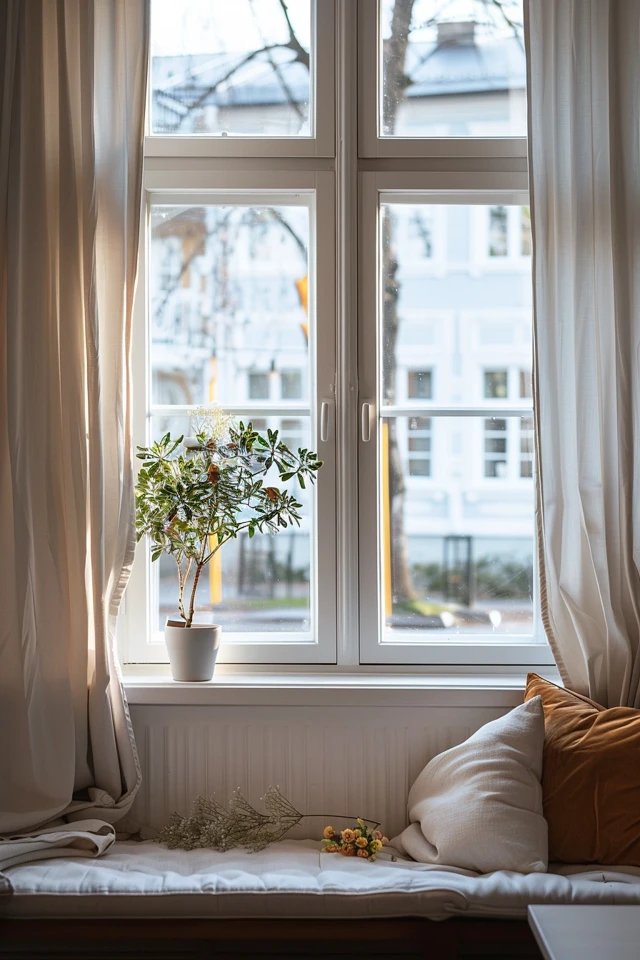Measuring a bay window for curtains can be a daunting task, but with the right guidance, it can be a breeze. Bay windows come in different configurations, such as two-angle, three-angle, and four-angle bays. The angles between the windows may determine whether the window should be treated as a bay or bow window. Accurate measurements are essential to ensure that your curtains fit perfectly and enhance the beauty of your bay window.
When measuring a two-angle bay window for curtains, you’ll need to measure the length of each window panel as well as the total depth and width of the window. For a three-angle bay window, measure the length of each window panel, the depth of the window, and the total width. Finally, for a four-angle bay window, measure the length of each window panel, the total depth, and the total width. It’s important to include stackback allowance in your measurements to ensure that the curtains stack neatly when opened.
Remember to use a steel measuring tape for accurate measurements and write down your measurements on a worksheet to avoid any confusion. Taking precise measurements will help you determine the appropriate curtain size and ensure a flawless fit for your bay window.
Key Takeaways:
- Accurate measurements are crucial for properly fitting curtains on a bay window.
- Measure the length of each window panel and the total depth and width of the window to determine the curtain size for a two-angle bay window.
- For a three-angle bay window, measure the length of each window panel, the depth of the window, and the total width.
- Measure the length of each window panel, the total depth, and the total width for a four-angle bay window.
- Include stackback allowance in your measurements to ensure the curtains stack neatly when opened.

Tips for Measuring Bay Windows for Curtains
When it comes to measuring bay windows for curtains, there are a few important tips to keep in mind to ensure accurate measurements and a perfect fit. By following these best practices, you can confidently select the right curtain length and width for your bay windows.
Measure in centimeters: Most curtain measurements are typically in centimeters, so make sure to use a metric measuring tape for precise measurements.
Get a second pair of hands: Measuring larger bay windows can be challenging on your own. Enlist the help of a friend or family member to assist you in measuring accurately, especially when dealing with multiple angles and dimensions.
Measure at the installation location: It’s important to measure the bay window at the exact location where the curtain poles or tracks will be installed. This ensures that your measurements account for any obstructions or variations in the window frame.
Don’t assume symmetry: Bay windows often have unique configurations, and each side may have slightly different measurements. Avoid assuming that your bay window is perfectly symmetrical and measure each side individually for a precise fit.
Add extra width for pole allowance: To ensure your curtains can be fully drawn back, add an additional 15cm or more to the first and last sides of the bay. This allowance allows the curtain poles or tracks to extend past the window onto the wall, providing a clean and functional look.
By following these tips, you’ll have the confidence to measure your bay windows accurately and select the perfect curtains for a beautiful and functional window treatment.
“Accurate measurements are key to achieving the perfect fit for your bay window curtains.”
Next, we’ll explore how to create a window template and other important considerations for measuring bay windows for curtains.

Making a Window Template and Additional Considerations
When it comes to measuring bay window depth for curtains, creating a window template can ensure a perfect fit. Start by laying a large piece of paper on the floor, aligning it with the front edge of the bay window. Using a craft knife, carefully cut along the back and sides of the window, mimicking its shape. Once you have the template, don’t forget to clearly mark it with your name and address before sending it to the curtain supplier. They will use the template to create custom rods for your bay window curtains.
Another important consideration when measuring bay windows is the space available for the brackets. Determine whether the brackets will be fixed to the wall or the ceiling. Additionally, measure the distance between the top of the window and the ceiling to determine the type of bracket needed. By taking these factors into account, you can ensure that the curtains will hang properly and without obstruction.
Remember, when measuring bay windows, it’s crucial to use a straight line and make adjustments for any irregularities or angles in the window. Each measurement should be precise to achieve the best possible fit. Whether you’re making a window template or taking measurements, it’s essential to approach the task with detail-oriented focus. By considering these factors and following these steps, you’ll be well on your way to achieving the perfect fit for your bay window curtains.


